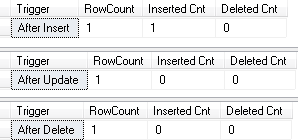The only correct way of writing triggers is not writing them. I would repeat – the only correct way of writing triggers is not writing them. Triggers negatively affect performance. AFTER triggers introduce fragmentation and increase tempdb load due to version store usage. Triggers are running in context of transaction, increase the time in which locks are held and contribute to locking and blocking in the system. However, in some cases, we have to use triggers and it is important to develop them correctly.
SQL Server fires triggers on statement rather than row level. For example, if update statement modified 10 rows, AFTER UPDATE and/or INSTEAD OF UPDATE trigger would fire once rather than 10 times. Therefore, trigger must handle situations when inserted and/or deleted tables have multiple rows. Let’s look at the example and create a table with AFTER INSERT trigger as shown below:
create table dbo.Data ( ID int not null, Value varchar(32) ) go create trigger trgData_AI on dbo.Data after insert as /* Some code */ declare @ID int set @ID = (select ID from inserted) /* Some code */
Everything is fine when you inserted a single row. However, multi-row insert would fail with exception shown below.
Msg 512, Level 16, State 1, Procedure trgData_AI, Line 9 Subquery returned more than 1 value. This is not permitted when the subquery follows =, !=, <, <= , >, >= or when the subquery is used as an expression. The statement has been terminated.
And there is another consequence of statement-level nature of triggers. They fire even if DML statement did not modify any rows. Would it introduce any issues in the system or not depends on implementation. However, it would always lead to unnecessary performance overhead.
Let’s look at example. The code below creates another table and changes trigger in a way, that mimics behavior of audit functional, which is frequently implemented based on triggers.
create table dbo.Audit ( ID int not null identity(1,1), OnDate datetime2(0) not null constraint DEF_Audit_OnDate default getutcdate(), Message varchar(64) not null, ) go alter trigger trgData_AI on dbo.Data after insert as begin declare @Msg varchar(64) = 'Triggers are bad. And @@ROWCOUNT=' + convert(varchar(10),@@rowcount) insert into dbo.Audit(Message) values(@Msg); end
Now let’s run insert statement, which does not insert any rows to the table.
insert into dbo.Data(ID, Value) select 1, 'ABC' where 1 = 0
If you checked content of Audit table, you would see that trigger was fired:
So the first important conclusion is that every trigger must checks @@ROWCOUNT variable as the very first statement in implementation.
SET NOCOUNT ON should be the second action trigger does. Without that SQL Server returns affected number of rows for each operator in the trigger in addition to original DML statement. Some client libraries rely on the single message in the output and would not work correctly in case of multiple messages. Therefore, the first two statements in the trigger should look like it is shown below.
alter trigger trgData_AI on dbo.Data after insert as begin if @@ROWCOUNT = 0 return set nocount on /* Some Code Here */ end
Finally, there is another caveat. While implementation above works for insert, update and delete operators, it is not the case with merge. @@ROWCOUNT in this case represents total number of rows affected by merge statement rather than by individual insert, update or delete action in the trigger. Let’s prove it with the example.
create table dbo.Data2(Col int not null) go create trigger trg_Data_AI on dbo.Data2 after insert as select 'After Insert' as [Trigger] ,@@RowCount as [RowCount] ,(select count(*) from inserted) as [Inserted Cnt] ,(select count(*) from deleted) as [Deleted Cnt] go create trigger trg_Data_AU on dbo.Data2 after update as select 'After Update' as [Trigger] ,@@RowCount as [RowCount] ,(select count(*) from inserted) as [Inserted Cnt] ,(select count(*) from deleted) as [Deleted Cnt] go create trigger trg_Data_AD on dbo.Data2 after delete as select 'After Delete' as [Trigger] ,@@RowCount as [RowCount] ,(select count(*) from inserted) as [Inserted Cnt] ,(select count(*) from deleted) as [Deleted Cnt] go
Now let’s run MERGE statement as shown below:
merge into dbo.Data2 as Target using (select 1 as [Value]) as Source on Target.Col = Source.Value when not matched by target then insert(Col) values(Source.Value) when not matched by source then delete when matched then update set Col = Source.Value;
The table is empty, therefore only one insert statement would be executed. However, as you should see below, all three triggers were fired, It is worth mentioning that previous code example demonstrated very bad practice of returning result sets from trigger. You should avoid doing it in production code.
The right way to deal with such situation is checking content of inserted and deleted tables as shown below.
alter trigger trg_Data_AI on dbo.Data2 after insert as if @@rowcount = 0 return set nocount on if exists(select * from inserted) /* Some Code Here */ go alter trigger trg_Data_AU on dbo.Data2 after update as if @@rowcount = 0 return set nocount on if exists(select * from inserted) and exists(select * from deleted) /* Some Code Here */ go alter trigger trg_Data_AD on dbo.Data2 after delete as if @@rowcount = 0 return set nocount on if exists(select * from deleted) /* Some Code Here */
I hope that those tips will help you to write trigger in the most optimal way. However, I would repeat – the best way of writing triggers is not writing them at all.
